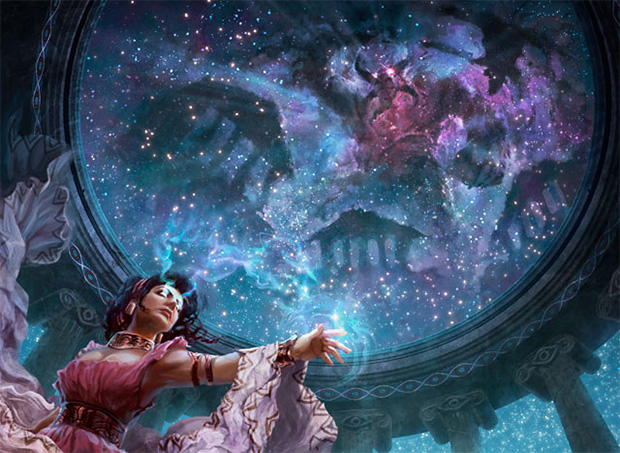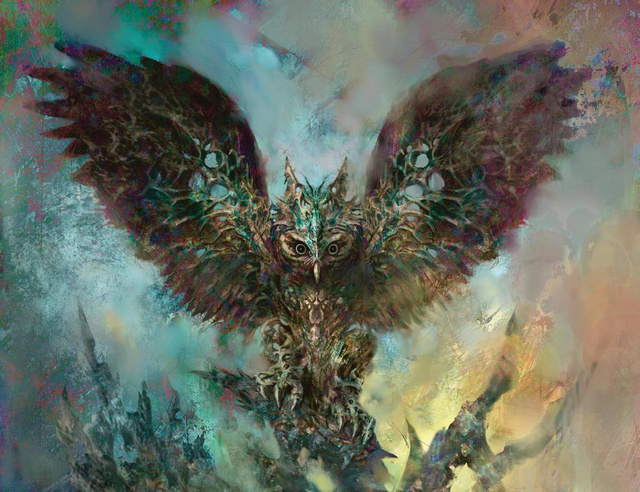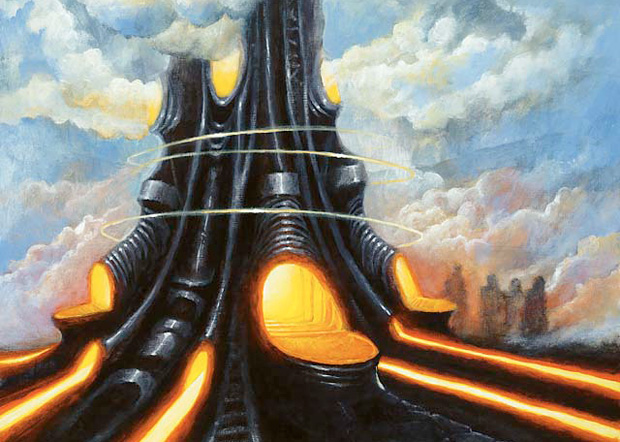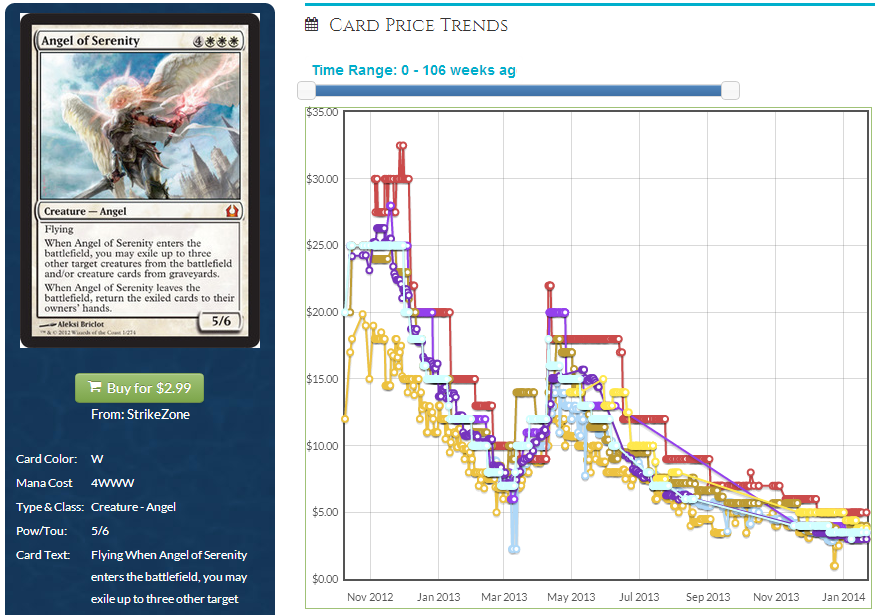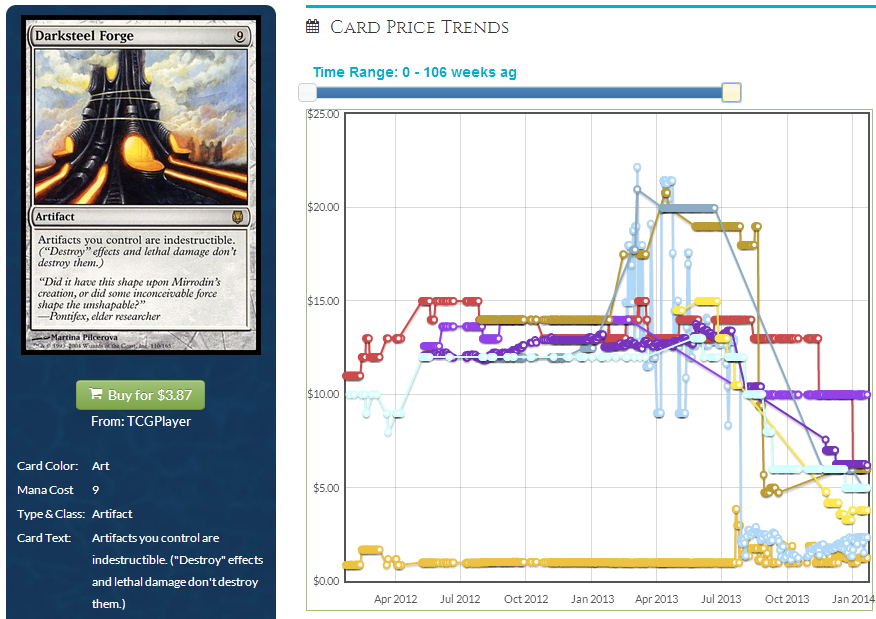By: Jared Yost
Another set release is upon us and this time it is Born of the Gods, the second set in the Theros block. My first opinions of the set, after reviewing it as a whole on Friday after all the spoilers were revealed, was that it is pretty lackluster. Outside of a few cards that stood out to me, I wasn’t too pleased that Theros block at this point seems to be a reimagining of Shadowmoor / Eventide block without the awesomeness of hybrid spells and permanents.
Devotion = Chroma (These mechanics are functionally the same)
Inspired = Untap Symbol (Although the Untap ability is much stronger since it essentially gives the creature pseudo-Vigilance plus an effect)
Bestow = Persist (Though clearly different for constructed formats, for limited the mechanics work the same by ensuring that if a creature you control would die you instead get a creature that is slightly less powerful. Most would argue that Persist is stronger since it only involves one card and Persist creatures generally have enter the battlefield effects.)
Don’t even get me started with Tribute – we’ve already tried this in the past and the Judgment punisher cards weren’t seriously Constructed playable. Even in Limited I would be very cautious about playing Tribute cards, as a choice card where the choice lies with your opponent will never turn out in your favor if the player’s skill level is moderate or higher. I understand why Wizards wanted to include them though, since casual players love Browbeat and some of the new Tribute cards could mirror that popularity.
Back to the positives – Scry is continuing in this set, and the interaction between Heroic and Bestow should not be underrated. The gods also look pretty cool.
With that said, let’s go through cards that have piqued my interest. Last time I had a ranking that I used for the cards I liked. These categories indicate what I think is the best strategy to pursue when determining if you want to pick up cards in Born of the Gods. They are:
-
ACTIVE PICKUP – About two weeks after the set’s release, the crazy preorder and release prices will die down. At that point, try to acquire more than just a playset. These cards have a lot of room to grow.
-
PASSIVE PICKUP – Pick these up if you feel you will need them for your Standard deck in the short term. Otherwise, wait for event results to start rolling in before you invest in more than a playset.
-
HOLD OFF – Wait one-and-a-half to two months and then buy in at the target price. These cards may eventually see heavy play in Standard, however the price is too high to take the risk right now.
-
BULK BUY – These are the Sanguine Bonds and Darksteel Plates of Born of the Gods. If you are interested in more formats than Standard or are comfortable with long-term investments, these have strong potential. If you are only a Standard player I do not recommend Bulk Buy cards because it may take months or even years for the card to produce returns.
Mythics
D(jk2m2389/i4NkDCksvL_EN.jpg)
Brimaz, King of Oreskos
Current Price: $23-$25
Target Price to Buy In: $18-$20
Reasoning: Even though Brimaz has the highest preorder price at $23-$25, there is a lot of potential for a mono white or W/u devotion deck to appear in Standard on the back of this card. Many players are very excited about him and so am I.
Yet, three signs are a warning me about avoiding this card – his heavy commitment to white in the casting cost, his legendary status, and his lack of an immediate effect on the field. Despite these “shortcomings,” Brimaz has the potential to be BNG’s Voice of Resurgence. I missed out on Voice which I also considered preordering at $25, which is why I am so heavily considering Brimaz as a trade or acquire target. He is cheap enough at three mana and will assuredly be popular with the casual crowd.
Considering all of the information I have at this point, I think it would be a good idea to preorder (or pickup as soon as possible) at least two to three Brimaz at the current price if you know you want to play him. If you are looking at Brimaz for a longer term hold or incremental value, it would be best to avoid preordering or picking him up at a release, because he does have the potential to drop and stay low if the Standard opportunities don’t materialize.
Final Verdict: PASSIVE PICKUP
D(jk2m2389/mp4Hig7bV3_EN.jpg)
Kiora, the Crashing Wave
Current Price: $20
Target Price to Buy In: $5-$8
Reasoning: I am excited about Kiora as she is the first G/U walker. My excitement is tempered by the fact that she only has two starting loyalty at the price of four mana.
Kiora is very overpriced right now due to new planeswalker hype. Her abilities aren’t that exciting for the mana cost. Avoid at $20 and trade away any copies you get for cards with a more stable price. Once she reaches her bottom price a little down the road it will then be time to pick her up.
Final Verdict: HOLD OFF
D(jk2m2389/lEBamA6i4h_EN.jpg)
D(jk2m2389/Rt7wmcmKCJ_EN.jpg)
D(jk2m2389/q1ep2CNflh_EN.jpg)
D(jk2m2389/tDdYNh3WHQ_EN.jpg)
D(jk2m2389/22FOAgZ8mm_EN.jpg)
BNG God Cycle
Current Prices:
- Xenagos: $20
- Mogis: $11
- Phenax: $9
- Karametra: $7
- Ephara: $7
Target Price to Buy In:
- Xenagos: $10-$12
- Mogis: $5-$7
- Phenax: $5-$7
- Karametra: $4-$6
- Ephara: $5-$7
Reasoning:
Xenagos: Xenagos has a really good chance of seeing Standard play. His ability to grant a creature haste and to double its power until end of turn is no joke – it can make turn five or six very bad for your opponent. I don’t like the fact that he costs five, however being in green helps. His legendary status and mana cost will prohibit the number of copies per deck, so $20 is very high.
Mogis: Unfortunately, Mogis’ ability is similar to Tribute where you give the opponent the choice to either take two damage or sacrifice a creature. If played in Jund, you could theoretically accelerate him out turn three, which could put your opponent in a bind. This is not enough for me to pick him up at $11. Mogis will retain some value due to Commander and Casual play. Right now he is too risky for me to pick up copies while the new set hype is in full swing.
Phenax: Phenax, God of Mill am I right? If mill becomes a deck in Standard (which I doubt) then he may surpass $15 as the backbone of the deck. Unfortunately, as mill is usually a casual strategy, expect Phenax to drop pretty quickly. Avoid at current prices.
Karametra: Probably the most “boring” god of the bunch. Really, mana ramp that costs me five mana and requires that I cast a creature spell? Ugh. On a positive note, this god will be a great Commander general and in the long term may become surprisingly popular due to this. You know the drill though – don’t buy into cool new god hype.
Ephara: Well, here we go! This is the god that I am most focused on because of its interaction with Brimaz. If you have a Brimaz blocking and attacking with Ephara out, that is a card drawn each upkeep! Considering that this is only an interaction between cards in the same set, I am sure there are countless others out their brewing heavily with Ephara as a centerpiece card utilizing the entire Standard card pool. I think that $7 is a fair price for Ephara. She definitely has the potential to go up, and even if she drops I don’t see her going below $4. I would hold on to any copies you pick up at the prerelease.
Final Verdict:
- Xenagos: HOLD OFF
- Mogis: HOLD OFF
- Phenax: HOLD OFF
- Karametra: HOLD OFF (with the potential for BULK BUY for mythic)
- Ephara: ACTIVE PICKUP
D(jk2m2389/41KfQyd3sS_EN.jpg)
D(jk2m2389/LkEH61s2PF_EN.jpg)
D(jk2m2389/8nRIb8xmVD_EN.jpg)
Other Mythics
Current Price:
- Flame-Wreathed Phoenix: $7
- Chromanticore: $2
- Champion of Stray Souls: $2
- Target Price to Buy In: ALL $1-$2
Reasoning: I don’t really like the final mythics for targets because of Tribute on Phoenix and the ultra-casualness of the other two cards. Phoenix I believe is a trap – it is a card that looks good on the surface yet because your opponent gets the final say it will wind up being underwhelming. Avoid these mythics because I feel like they will all drop a lot in the next few months.
Final Verdict: ALL – BULK BUY
Rares
D(jk2m2389/HTddbUnyqb_EN.jpg)
Spirit of the Labyrinth
Current Price: $7
Target Price to Buy In: $3-$4
Reasoning: Spirit of the Labyrinth is the legacy bone that Wizards has thrown in BNG. I don’t foresee it making a big impact in Standard, as card draw is rather lacking outside of Sphinx’s Revelation. In legacy this card will shine as there are lots of decks that want to draw piles of cards every turn. A hate bear similar to Thalia, I expect it to drop considerably while in Standard and to later pick up steam once rotation hits.
Final Verdict: HOLD OFF
D(jk2m2389/LGuIRMawV3_EN.jpg)
D(jk2m2389/ZXFIIYtWAw_EN.jpg)
D(jk2m2389/fpJ3hmJ2Xh_EN.jpg)
BNG Temples
Current Price: ALL $4.50
Target Price to Buy In: ALL $2-$3
Reasoning: Similar to the Theros temples, as long as shocklands exist in Standard these will always be second rate. Not to say that they won’t be played – I believe we will start seeing the BNG lands in more decks to help create three color strategies again. Right now though, they are overpriced until more are added to the card pool through opened packs.
Final Verdict: HOLD OFF
D(jk2m2389/Ai83Ucc9o8_EN.jpg)
Herald of Torment
Current Price: $2.50
Target Price to Buy In: BULK
Reasoning: Herald of Torment is quite an efficient flyer, which makes me sad to say it lacks the level of power needed to be included in the current mono black devotion deck. Desecration Demon and Nightveil Specter are still better for the deck’s strategy, so I don’t see Herald making waves in the current standard. Once RTR block rotates and Theros block becomes harder to find, then I believe Herald may have time to shine.
Final Verdict: BULK BUY
D(jk2m2389/nV1WCd9gFZ_EN.jpg)
Hero of Iroas
Current Price: $2
Target Price to Buy In: BULK
Reasoning: I don’t see Hero of Iroas making an impact in constructed formats. I would say it looks enticing to casuals as a future all-star in those sixty card aura decks that you see casual players beating each other with from time to time. Wait for him to go down to bulk status in Standard, then pick up extra copies for future gains.
Final Verdict: BULK BUY
D(jk2m2389/rdVDFIGwgs_EN.jpg)
Hero’s Podium
Current Price: $1
Target Price to Buy In: BULK
Reasoning: Heroes’ Podium is full of flavor and many casual players are going to love this card for Commander. Not only does it provide a Coat of Arms effect to only your legendary creatures, it can also fetch them from the top of your deck for the right amount of mana. This won’t be making any waves at your local PTQs so the strategy here is to acquire foils and non-foils slowly and cheaply over a longer period to build up future value.
Final Verdict: BULK BUY
D(jk2m2389/Zc9QRvTe3Z_EN.jpg)
Fate Unraveler
Current Price: $1
Target Price to Buy In: BULK
Reasoning: I don’t see her being played in Standard and instead appealing to casual players as yet another card to put into their Nekusar Commander deck. I don’t see her going above $1 for a long time, so if you pick up any just be aware that it could take some time for Unraveler to rise. Foil copies have a lot of opportunity in the long term.
Final Verdict: BULK BUY
D(jk2m2389/4yt5zEp7Gp_EN.jpg)
Whelming Wave
Current Price: $1
Target Price to Buy In: BULK to $1
Reasoning: I actually see this impacting Standard. Evacuation was an OK card when it was legal, and this is just a flavorful version of that card. Sorcery speed is a drawback, yet a board wipe is a board wipe and people do play Cyclonic Rift.
Final Verdict: PASSIVE PICKUP
Rares I Could Not Find a Price For, But Look Out for Them
D(jk2m2389/91emPZyKqc_EN.jpg)
D(jk2m2389/Us7iSUdyMu_EN.jpg)
D(jk2m2389/BTufupYL0A_EN.jpg)
D(jk2m2389/HHE9ZZ8ypL_EN.jpg)
D(jk2m2389/mxuTuLyOIU_EN.jpg)
D(jk2m2389/vDfoa3Y3AS_EN.jpg)
Eidolon of Countless Battles
Plea for Guidance
Fated Retribution
I like these three white rares for casual decks and not much more. Pick them up for bulk prices if you plan on playing them in Commander. It will be quite a while before they go over bulk prices.
Astral Cornucopia
Courser of Kruphix
Gild
Astral Cornucopia is the new neat Standard version of Coalition Relic. For Standard I think it could be strong as it promotes three color decks again like Coalition Relic did. This artifact could be the tool that pushes three color decks.
Courser of Kruphix is nice for R/G monstrous ramp decks in Standard though I don’t see it being worth that much. It will definitely appeal to casuals, which in the future could boost its price, and this means it is not a pickup for the short term. Pick up for bulk if you can but otherwise wait for more results to come in.
Gild is a cool new removal spell for Standard that also promotes three color builds, so I can see it being used to help boost Jund or Esper decks. Not sure if it will go over $2-$3, however I think it is worth it to pick up two or three copies in case it starts seeing a ton of play.
Uncommons
D(jk2m2389/iWWhmCTxlJ_EN.jpg)
D(jk2m2389/oy825UMRB2_EN.jpg)
D(jk2m2389/D9ZaGtJnL8_EN.jpg)
D(jk2m2389/gtMyp0soSV_EN.jpg)
D(jk2m2389/ivAO0BtOMY_EN.jpg)
D(jk2m2389/SymKWGCPCE_EN.jpg)
Searing Blood: Even though this only deals damage to creatures, I compare it to Searing Blaze from Worldwake. Four copies of Searing Blaze were played in many decks, and Searing Blood could see just as much play. Don’t be surprised if it sees prices of more than $1 in the future. Don’t pick them up for more than $0.50 for now and hold onto any extra copies that you may acquire in the future.
Fanatic of Xenagos: I really like this creature because the Tribute almost doesn’t matter. Either I get a 4/4 Trample Haste, or a 4/4 Trample without haste? Seems pretty good. I realize that he becomes 3/3 without Tribute, but the haste could really matter for that extra damage. I expect this uncommon to be a big hit with the casual crowd which will help to bolster the price. Hold on to any extra copies you get and try to get them as throw-ins.
Bile Blight: Wow, as if black needed more great removal. Pick them up cheap and hold them for a rainy date when BNG is harder to find.
Drown in Sorrow: Upgraded Infest, yeah! Another sweet black tool that will keep the mono black devotion deck relevant. Get these as throw-ins too because I bet next year they’ll be worth a decent amount while they are still in Standard.
Kiora’s Follower: Sweet casual card with a nice Standard upside of untapping Nykthos. Even though this does not guarantee inclusion, this guy will still have casual appeal which should help buoy the price. Either way I expect him to retain a price of $0.50 or more retail forever, which is solid for an uncommon. The name means he is hard to reprint so in the far future these could break $2 or more.
Ragemonger: Like Kiora’s Follower, I’m not sure if it will be played in Standard, but it does have the casual appeal to back it up by being a Minotaur tribe enabler. It’s a shame that Mogis isn’t a Minotaur, but as the saying goes you can’t always get what you want. Acquire several copies at the current going price. You never know if Minotaurs will become a thing once Journey Into Nyx is released.
Conclusion
Although Born of the Gods on the surface appeared to be quite dull, I found there are still interesting cards in the set that may not be for Standard that nonetheless have financial implications in the future.
For the most part, prices of the cards will drop and I recommend waiting to pick them up at their lower prices unless you absolutely need them for a Standard deck. If you feel that any of the cards I have evaluated should be reassessed I encourage you to leave a comment and explain your reasoning. In addition, if you feel that I have missed any important cards for the upcoming Standard environment you should likewise feel free to comment and let me know.
